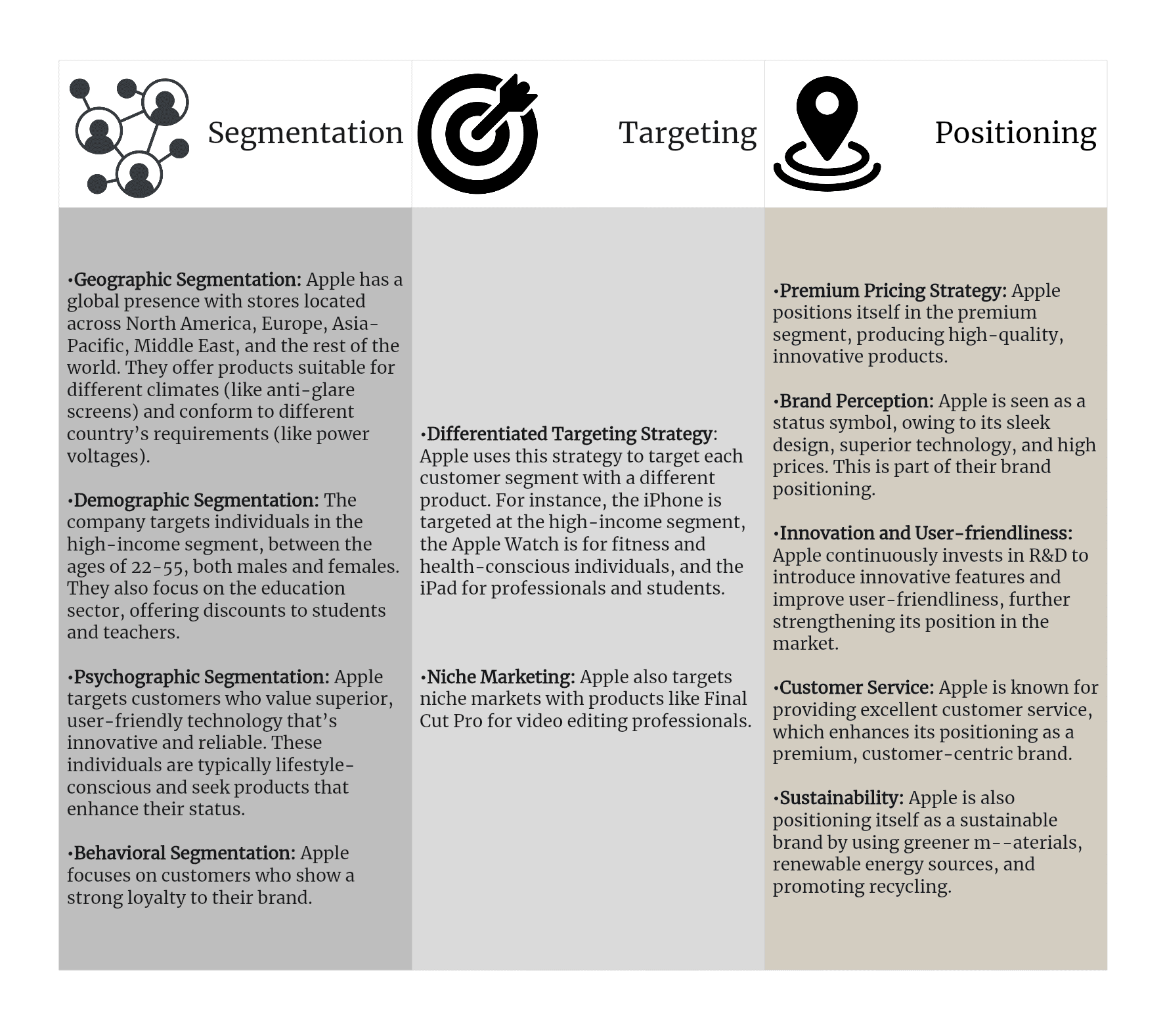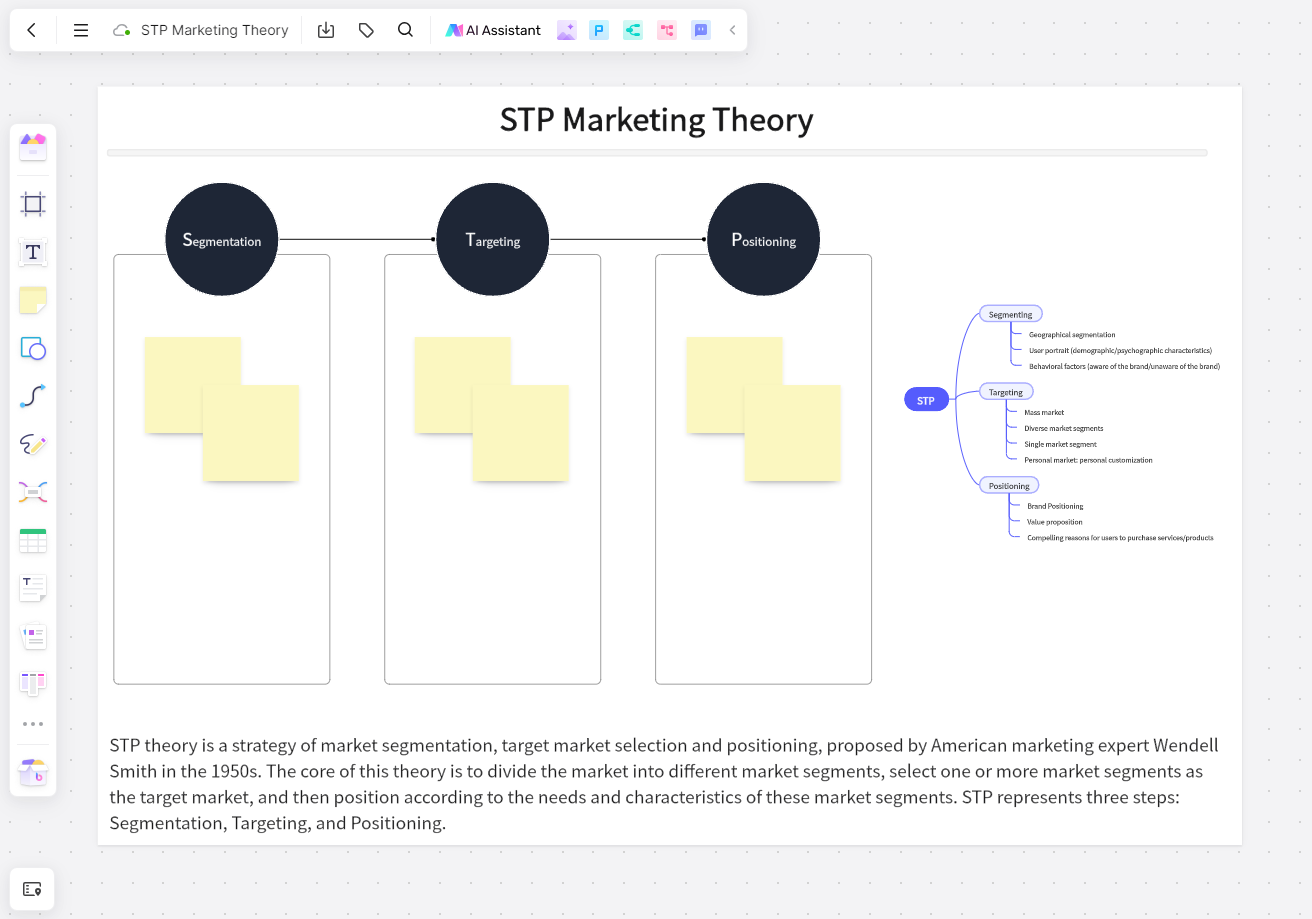The essence of the world's most valuable brand,Apple Inc, lies not only in its pioneering technology but also in its dynamic strategy for segmentation, targeting, and positioning (STP). This article seeks to explore this strategic framework in-depth and demonstrate why Apple reigns supreme.
Apple Segmentation, Targeting, and Positioning Mind Map
Let's embark on our journey by envisioning a mind map that will serve as our guiding tool. This visual representation will lead us through the intricacies of Apple's strategy for segmentation, targeting, and positioning. Acting as our compass, this mind map will enable us to navigate these three vital areas, starting with an exploration of Apple's market segmentation. We will then delve into their targeting strategy and emerge with a profound comprehension of their positioning tactics.

Design Your STP Mindmaps For Free
Market Segmentation of Apple
Understanding the genius behind Apple's strategic marketing framework begins by delving into its market segmentation. Market segmentation refers to the practice of dividing a broad market into distinct groups with common characteristics and needs. This aids in tailor-making marketing strategies that specifically cater to each segment's preferences.
Apple, over the years, has masterfully implemented this concept, using several key parameters to differentiate their consumer base: geographic, demographic, psychographic, and behavioral segmentation.
Geographic Segmentation
Apple has a broad geographic reach, covering both developed and emerging markets around the globe. From North America to Europe to Asia-Pacific, Apple products are universally sought after. A significant factor driving this widespread appeal is Apple's reputation for delivering high-end, innovative products that are in sync with evolving technological trends.
Their flagship stores, designed as architectural marvels and strategically located in major cities worldwide, significantly enhance their global presence. Further, they maintain a robust distribution network through tie-ups with authorized resellers and leading e-commerce platforms.
Demographic Segmentation
When it comes to demographic segmentation, Apple's offerings span across different age groups and genders. They've strategically broadened their product portfolio to appeal to diverse demographics. Their Mac computers are widely popular amongst professionals for their seamless design and high-performance capabilities.
Their iPhones are equally popular amongst teenagers, young adults, and the middle-aged population, thanks to their user-friendly interface, sleek design, and status symbol representation. iPads and iPods too, find favour among a broad demographic spectrum - from kids captivated by interactive learning games to senior citizens using user-friendly apps for healthcare monitoring.
Psychographic Segmentation
Psychographic segmentation considers attributes like lifestyle preferences, attitudes, and personality traits. In this context, Apple has done exceedingly well. They cater to individuals who seek exclusivity and superior design. Apple products are a lifestyle statement - an embodiment of elegance, sophistication, and innovative technology.
Their products appeal to creative professionals, tech enthusiasts, and individuals who appreciate an elevated aesthetic appeal in their devices. Consumers who choose Apple value its sleek design, exclusive features like Retina Display or Face ID, seamless hardware-software integration, and the prestige associated with owning an Apple device.
Behavioral Segmentation
Lastly, behavioral segmentation is also at play. This type of segmentation is based on consumer's product knowledge, usage rate, loyalty status, and benefits sought.
The loyalty that Apple commands amongst its users is legendary. Many users are dedicated followers of the brand and consistently upgrade to the latest models on release. Moreover, Apple users often use more than one Apple product - an iPhone user might also own a MacBook or an iPad or use services like iCloud or iTunes – indicating the strong trust and dependence on the brand.
In essence, Apple’s market segmentation strategy reflects its commitment to understanding consumer needs at a granular level. By segmenting its markets aptly, Apple delivers products that aren't merely gadgets but extensions of the individual's personality and lifestyle preferences. This meticulous approach to market segmentation has indubitably played a significant role in cementing Apple's reputation as a world-class brand.
Targeting of Apple
Once a comprehensive market segmentation is in place, the next pivotal step in the strategic marketing framework is targeting. Apple's targeting strategy involves identifying and understanding the specific customer segments to which its products will be marketed. The beauty of Apple's targeting strategy lies in its selectivity and precision - their products aren't meant for everyone, but for those who appreciate innovation, design, and are willing to pay a premium for these elements.
Affluent Consumers
At its core, Apple targets the premium segment of the market. Affluent individuals and households who view technological devices as more than mere gadgets are a significant target for Apple. They seek targeted consumers willing to pay higher prices for superior design, seamless user experience, and the prestige that comes with owning an Apple product. This focus on the high-end market allows them to maintain high-profit margins, a key element of their business model.
Business and Professional Segment
Over the years, Apple has made significant inroads into the business and professional segment, becoming the go-to brand for many companies, entrepreneurs, and professionals. The superior performance, advanced features, robust security, and excellent customer service that characterize Apple products are highly appealing for this segment. Products like MacBook Pro or the iMac are highly sought after by professionals requiring high-end computing solutions. Similarly, the iPhone's seamless integration with various business apps makes it a preferred choice for many professionals.
Education Sector
Apple has also successfully penetrated the education sector with products like iPads and MacBooks, and services like Apple Pencil. Their focus here isn't just schools and universities but also students and teachers. Apple's user-friendly design and engaging features offer effective e-learning solutions, especially relevant in the present times of digital learning. They offer discounted rates and special packages for educational institutions, making their products more accessible to this segment.
Tech-savvy Youth
Another critical target segment for Apple is the tech-savvy youth who are drawn towards trendy and innovative gadgets. With an iPhone or a MacBook being seen as a status symbol among many young people, this demographic forms a significant portion of Apple's consumer base.
In essence, while Apple’s products have universal appeal, their focus is clearly on segments that value quality over price. It's a brand for those who want the best and are willing to pay for it. This clear identification of their target segments allows Apple to design and market their products more effectively, catering to the specific needs of each segment while maintaining their brand image and profitability.
Positioning of Apple
Positioning is the last cog in the strategic marketing wheel, playing an instrumental role in how a brand's offering is perceived in the mind of the consumer. It's about carving a unique image and identity for the brand that distinguishes it from competitors. Apple's positioning strategy is a shining testament to this principle, crafting a unique space for itself as a leader of innovation and a premium lifestyle brand.
A Brand Synonymous with Innovation
Apple's market positioning has always been aligned with being an industry leader when it comes to technological innovation. From the launch of the revolutionary iPhone in 2007 to the introduction of advanced features like Siri and Face ID, Apple consistently pushes the boundaries of technology. This persistent emphasis on innovation reinforces their position as an industry pioneer, setting them apart from their competitors.
Superior Design and Aesthetics
Another critical facet of Apple's positioning strategy is its emphasis on superior design and aesthetics. Whether it's their signature minimalist product design or the thoughtfully designed user interface, every aspect exudes elegance and sophistication. They offer a seamless integration of hardware and software that translates into a superior user experience. By focusing on design elements as much as on technical specifications, Apple positions itself as a brand that values aesthetics and functionality equally.
Prestige and Exclusivity
One of the more subtle aspects of Apple's positioning strategy lies in how it communicates prestige and exclusivity. Owning an Apple product is seen by many as a status symbol. This is largely due to Apple's high price point, which creates an aura of exclusivity around their products, appealing to consumers who take pride in owning top-of-the-line gadgets.
Customer Centricity
Apple has positioned itself as a brand that places significant importance on customer satisfaction. From providing exceptional customer service to ensuring regular software updates for device performance optimization, every touchpoint reiterates their commitment to customer centricity.
Powerful Brand Messaging
Apple's iconic tagline - 'Think Different' - encapsulates their positioning philosophy. By encouraging users to break away from norms and harness the power of technology to change their world, Apple fosters a strong emotional connection with its customers. This powerful brand messaging has played an instrumental role in creating a loyal customer base worldwide.
To conclude, Apple's positioning strategy has been key to its phenomenal success. The company has successfully positioned itself as a luxury brand offering innovative, design-led products that deliver an unmatched user experience. With this positioning, Apple doesn't merely sell products; it sells an experience that keeps customers coming back for more.
Apple Segmentation, Targeting and Positioning Analysis Cheat Sheet
Every aspect of Apple's STP strategy conveys a commitment to quality, innovation, and design excellence.

Key Takeaways: STP Template & Tool
In summary, the effectiveness of Apple's segmentation, targeting, and positioning strategy is a significant factor contributing to its global success. It showcases a nuanced understanding of its customer base and leverages that knowledge to deliver superior products that resonate deeply with users.
To execute your own effective STP analysis and build strong brand strategies like Apple's, we highly recommend using Boardmix's pre-built Market Segmentation Template and STP Analysis Template. These tools provide a structured approach that can guide your strategic marketing decisions.

With digital canvas, Boardmix empowers users for online collaboration involving sceneries like design research, marketing analysis, business plans, daily meetings, weekly plans, and online education. It offers the one-stop solution of an online whiteboard, flowcharts, mind maps, brainstorming, hybrid work, scrum tools, and so on. Boardmix also integrated comprehensive AI-generation features like AI Presentation, AI Image, AI Mind Map, and so on. BoardMix's online whiteboard combines advanced technology with ease of use, simplifying team brainstorming, data analysis, document drafting, and information visualization. Try this excellent diagram tool and make your STP analysis for free on Boardmix!








